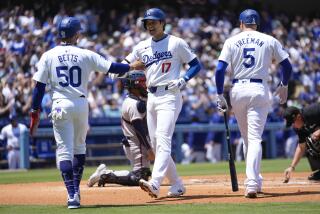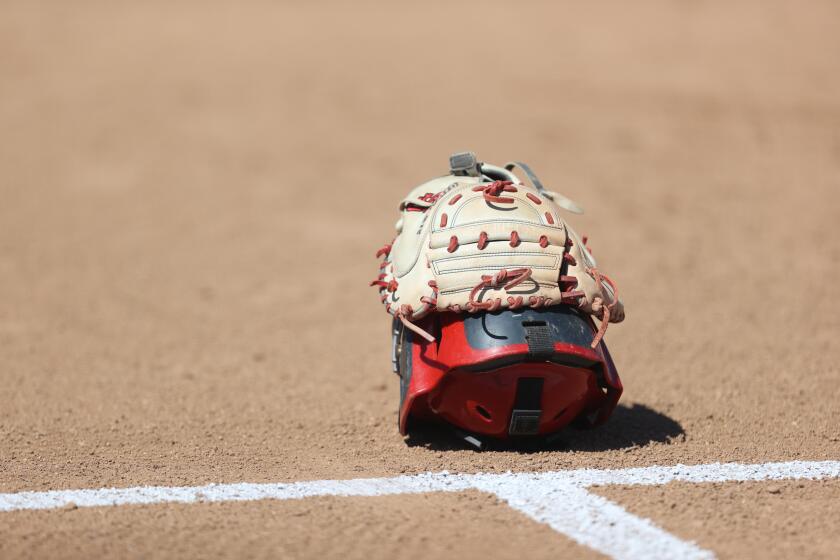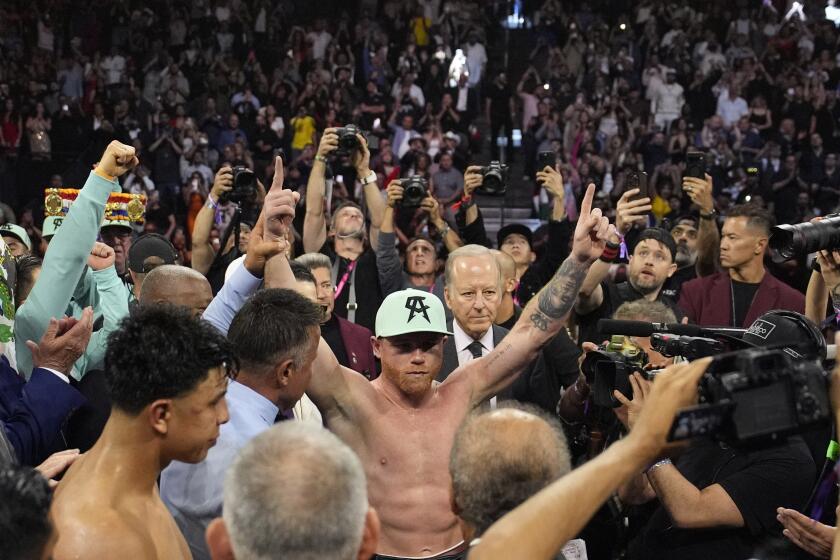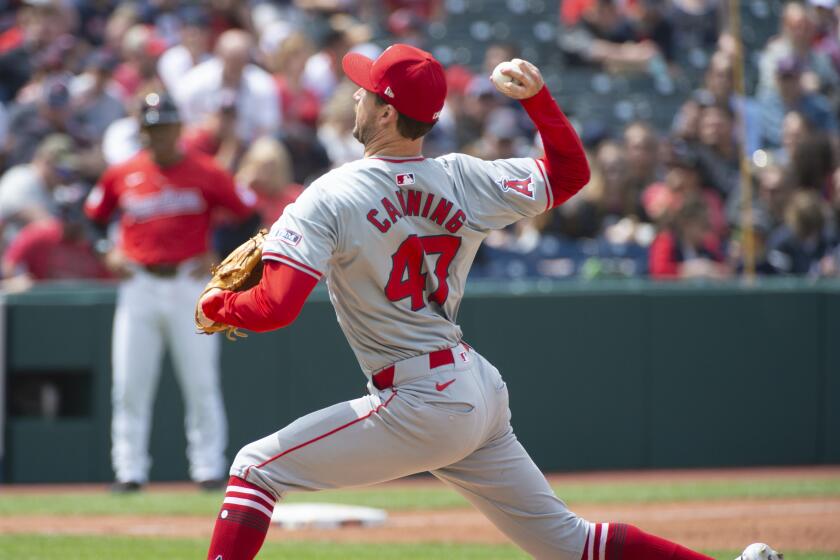Lords and Legends : Nelson, Hogan and Snead All Part of the History of L.A.’s ‘Minor Major’
In 1946, when Byron Nelson was 34, he noticed a hole in his resume. The way Nelson figured it, he had won every important tournament in the United States, except one.
Nelson never had won the Los Angeles Open. He knew why, though. It was because he had so much trouble on the greens.
“I just couldn’t read them,” Nelson said. “They said everything broke toward the Pacific Ocean. Well, that was fine, except I couldn’t find the Pacific Ocean.”
Of course, the year before, when Nelson won 11 consecutive tournaments, his putts were dropping as if he were rolling them off a dock into that same Pacific Ocean.
Still, he hadn’t won in 11 tries in Los Angeles, two of them at Riviera.
But in 1946, Nelson spent four days in January marching across the barrancas and under the eucalyptus trees at Riviera, using 284 shots to triumph over Ben Hogan by five strokes. The victory brought Nelson $2,666.67 in prize money, but it was worth a lot more.
“The Los Angeles Open, we called it a minor major,” Nelson said. “It was a very, very important tournament. Always has been. It’s had such great winners, like Hogan, Jimmy Demaret, Sam Snead.
“You can tell a tournament by who wins it, and this one, well, it’s always had stature and I hope it always will.”
And so it goes at Riviera, where the 1997 Nissan Open begins today on the layout conquered by the likes of Hogan, Snead and Nelson.
But then, it’s also the place where such important figures as Bill Spiller, Ted Rhodes and Joe Louis advanced the fortunes of minority golfers decades before the Tiger Woods phenomenon.
Blacks and other minorities were not permitted to play the tour because of the so-called “Caucasian rule,” but the Los Angeles Open had no racial restrictions.
Ed Furgol, who played with Rhodes and Spiller in the 1948 event that Hogan won, remembers a conversation he had with Rhodes walking up the 18th fairway the last day.
“Ted was usually very quiet, very reserved, but here he was, cussing like heck, so I asked him what the matter was,” Furgol said.
“Ted told me he wasn’t going to be able to play [on the tour] the next week. But here he was with me. Ted straightened me out real quick. L.A. was the first tournament I knew of that didn’t restrict African Americans. It was very democratic, very American and that’s the way it should be.”
The first Los Angeles Open golf tournament was held at Los Angeles Country Club in 1926 and was billed as “The greatest golfing classic the West has ever known.”
The distinguished writer Damon Runyan was dispatched from New York to cover the event. It had a purse of $10,000, the largest on the tour.
In 1929, the first Los Angeles Open held at Riviera attracted so many golfers that a 36-hole round was needed to qualify and six courses were used.
To raise prize money, Will Rogers was master of ceremonies at a $100-a-plate dinner.
Geoff Shackleford, in his book “The Riviera Country Club,” wrote that Walter Hagen was one of the 1929 favorites but never recovered from his introduction on the first tee, given by actress Fay Ward: “And here he is, Walter Hagen, the opium champion of Great Britain.”
Ward delivered the line, wrote Shackleford, “with a straight face and not much knowledge of golf.”
According to legend, Hogan asked a boy from his gallery to set fire to some newspapers so he could have enough light to finish on the last day because of a late pairing and the short days of January.
With its $10,000 purse still a record, the Los Angeles Open at Hillcrest Country Club in 1942 was called “the start of the gold trail.” Burns and Allen emceed a pretournament luncheon, and a record 25,000 spectators watched Hogan win $3,500 by defeating Jimmy Thompson by a shot when he birdied the last hole of an 18-hole playoff.
In 1945, back at Riviera, it was Snead’s turn.
On the seventh hole the last day, he hooked his ball next to the base of a tree and had no shot to the green. But he tried anyway, smashing his five-iron against the tree in the process and bending it like a pretzel. Looks were secondary, however, because the ball landed on the green, 25 feet from the pin and Snead made his par and beat Jug McSpaden and Nelson by a shot.
Snead won again in 1950, defeating Hogan in a playoff, the same year Hogan returned to golf after a near-fatal auto accident.
Snead, who shot 66 on the last day, needed to birdie the last three holes to catch Hogan, and managed to do it, despite a slight distraction while he was putting on the 18th hole. A spectator fell out of a tree.
After Snead made the putt, another spectator made a spectacle of himself.
“Some guy jumps up for joy and trips and starts tumbling down the hill like a tumbleweed,” Snead said.
Thanks to awful weather, which seems to be another recurring tournament characteristic, Hogan and Snead didn’t get to their playoff until eight days after the final round, right after another downpour, Bing Crosby’s clambake at Pebble Beach and a scheduled women’s tournament at Riviera.
Snead, who used to stay at his uncle George’s house when he played the event, still has a warm spot in his heart for the tournament and for Riviera.
“It’s just tough to beat,” he said. “They really don’t have to do much with it. Any golf course where you can remember the holes, it’s a good golf course. And I’ve got every one of them stored away.”
The tournament moved into the 1950s and to Inglewood Country Club and Rancho Park, where players such as Gene Littler, Doug Ford and Ken Venturi won. In the 1960s, the names were Bob Goalby, Arnold Palmer, Billy Casper and Charlie Sifford.
In 1973, it was back to Riviera, where Dave Stockton, Hale Irwin, Lanny Wadkins, Johnny Miller, Tom Watson, Fred Couples, Tom Kite and Corey Pavin took their turns at winning.
Snead noticed a common thread.
“A nobody never won that tournament,” he said. “I always thought that Riviera was one hell of a course and the event was one hell of a tournament. I still do.”
More to Read
Get our high school sports newsletter
Prep Rally is devoted to the SoCal high school sports experience, bringing you scores, stories and a behind-the-scenes look at what makes prep sports so popular.
You may occasionally receive promotional content from the Los Angeles Times.






